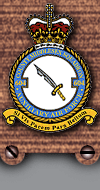SQUADRON
HISTORY
"Don't threaten or dictate to us untill you
are marching up Whitehall,
and even then we won't listen to you".
British Ambassador to German Envoy
Bern, Switzerland, May 1940
604 Squadron came into being at Hendon on the
17th of March 1930 with F/L F.J Fogarty as adjutant and flying
instructor,with a Warrant Officer and 19 airmen they formed
the nucleus on which the new squadron of part timers would be
built.
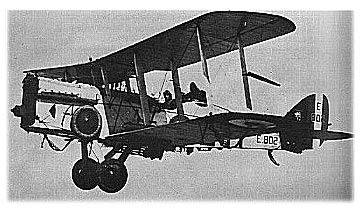
De
Havilland DH9
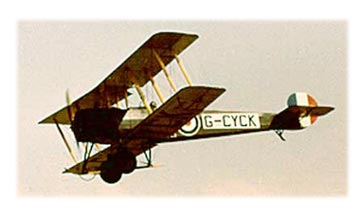
AVRO
504
The first aircraft on strengh were a De Haviland
DH9 ex 600 (City of London) sqdn, an Avro504K from 605 (County
of Warwick) sqdn and another DH9 from601 (County of London)
On the 11th of September the sqdn recieved its first operational
aircraft, these were Westland Wapitis and in May, 9 of these
aircraft took part in the great Hendon Air Pageant, one of the
countrys largest pre-war aviation events.
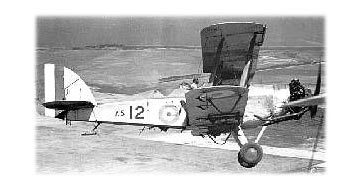
Westland
Wapiti
604 were affiliated with 32.(f). sqdn followed by annual camp
at Tangmere where they became a blueband bombing squadron. In
1932 the squadron was visited by Air Marshall HRH,The Prince
of Wales, the occasion was to present the squadron with the
coveted Esher Trophy for being the best all round squadron in
the Royal Auxiliary Air Force. Headquarters were opened in 1934
at Heath Brow, Hampstead by Vicount Trenchard, and during that
summer the role of 604 changed to that of a fighter squadron
from the light bomber duties it had started as, this was most
popular with all of the members!.
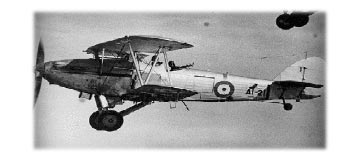
Hawker
Demon
After his 5 year stint S/L Gore handed over to S/L Gabriel
who was one of the first weekenders to qualify as a pilot with
604 sqdn. In 1935 Hawker Demons replaced the ageing Wapiti's
and four of these were detailed to take part in the annual Mildenhall
air review. 1936 saw the commisioning of a certain John Cunningham
and also the winner of the Esher Trophy and again in 1938 only
this time presented by ACM Hugh Dowding, also in this year the
Hendon pageant included 604sqdn and after summer camp the squadron
was called up and based at its wartime home of North Weald,
Essex.
In 1939 camp was held at Hawkinge, and on the 24th of August
the sqdn was embodied into the R.A.F. as a bone fide fighter
squadron and every single officer and airman was present for
this special occasion! On the 1st of September 1940 the Sqdn
flew into North Weald equipped now with Bristol Blenheim two
seat fighters.
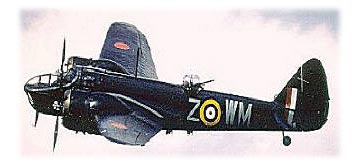
Bristol
Blenheim
After a period of night flying duties, such as checking factories
for blackout effectiveness and AA gun affiliation exercises,
604 became officially a night fighter sqdn. F/O Cunningham was
crewed with his A/G "Jimmy" Rawnsley by this time and in December
of 1939 had recieved their first "radar" equipped Bristol Blenheim
P4847. The sqdn moved to Martlesham Heath for extensive training
and to provide cover for the merchant ships using the East Coast
ports. A move to Kenley, Surrey, followed later that year to
cover the B.E.F's leave ships from France and on the 10th of
May they escorted Blenheim Bombers to the beaches off the Hague
where they attacked JU52 troop transports destroying 4 and damaging
4 others, one of 604's aircraft crashing in Holland, but the
crew escaped with aid from the dutch civilians nearby. This
was the first blood to the sqdn! The first night victory fell
to the guns of F/O Hunter, this was a JU88, and in September
to the great delight of all, the sqdn recieved its first Bristol
Beaufighter AI (radar) aircraft, the airgunners were dissapointed
with the lack of a gun turret but most were happy to re-muster
as radar operators, by this time John Cunningham was a F/L and
with a temporary R/O he destroyed a JU88 and in order to conceal
from the germans the existence of a functional radar system
the ruse was put about that F/L Cunningham posessed exceptional
night vision, hence the nickname of "cats Eyes" a name he did
not enjoy! This man, with "Jimmy" Rawnsley, went on to become
one of ,if not the most, succesful night fighter teams of the
Second World War.
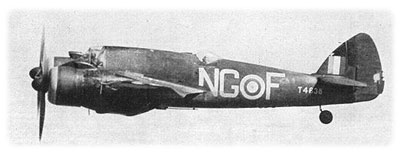
Bristol
Beaufighter
The victims of 604sqdn were often the aircraft of KG100 the
Luftwaffe's premier pathfinder squadron and, by the end of 1941,
the squadron had flown for 5,800 hrs, with 56 enemy aircraft
destroyed, 40 damaged, and had gained 2 D.S.O.'s, 10 D.F.C.'s
and a bar, 8 D.F.M.'s and 1 bar, 3 B.E.M.'s, to the ground crews,
and a M.E.B. to S/L Brown for his part in Sopley GCI.
Up to this date the squadron had lost 4 aircraft, with 8 crew
members dead, a sacrifice that should not be forgotten.
The career of 604 squadron continued throughout the Second
World War being based at Exeter from the 3rd of May and quickly
sharing success with No 307 (Polish) squadron, Flt/lt crew downing
a Do217 over Cowes, Isle of Wight over Studland Bay S/L skinner
despatched an He111 on the 24th of May another He111 was destroyed
by a new crew to 604 P/O Foster and Sgt Newton.
July saw the departure of John Cunningham for a rest period
after 6 years with the Squadron. It would be impossible to render
an account of all 604's victories here the source of this information
is best read in the excellent book "Twenty One Squadrons a Complete
History of the Auxiliary Squadrons of the Royal Air force".
Detachments of 604 operated from many airfields in England,
from Leeds to , Cornwall to Essex, the squadron was successful
on so many occasions, from downing the first He 177 four engine
Bomber over Sunderland to destroying an E-Boat in the English
Channel, for instance on the 27th of July S/L Hoy and W/Officer
Ray, intercepted "weather Willie" a fast moving Ju88 that radioed
reports for the U-Boat's and for Lord Haw Haws broadcasts, but
the Ju88 was forced to radio that he would not be returning
to base as he hit the sea! another "weather Willie" was destroyed
on the 22nd of august by Wing Commander Maxwell, Wing commander
Maxwell scored the squadrons 100th kill, and Wing Commander,
Desmond Hughes came into the squadron as its new C/O. He was
a former Boulton-Paul Defiant pilot from the Battle of Britain,
with a DFC and two bars for night fighting with 125 (Newfoundland)
squadron, and 600 (City Of London) squadron, his navigator was
Flt Lt Laurie Dixon DFC and Bar.
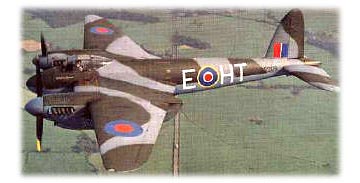
De
Havilland Mosquito
Wing Commander Maxwell left for a staff job 604 became equipped
with the Mosquito MkX11, and soon after the squadron was airborne
over the Invasion Beaches of Normandy. part of the squadron
was first based on French soil at A15 the allied tag for the
Cherboug-Maupertus aerodrome, the rest still based in the UK
at Blackbushe airfield to protect the supply ports for the Allies
in Normandy. A move to allied field A8 (Picauville) saw the
whole squadron together, seven aircraft airborne that night,
four aircraft destroyed, but with a loss to the squadron of
one aircraft, Flt Lt Hooper and F/O Hubbard DFC were never found.
By the 1st of september the airfield at A8 had deteriorated
so much that the squadron moved to B6 and then to B17 (Carpiquet)
near Caen, Flt Lt Miller cannoned two armed Trawlers near Jersey,
the squadron moved back to Preddanack Cornwall on the 24th of
September to rearm with the latest Mosquito variant with an
advanced new Radar. Another move to Odiham Hantshire saw 604
waiting to move back to France, but while here they made patrols
to Belgium and Holland and in emergencies were able to land
at Brussels-Melsbroek as this was now in allied hands, they
were under control of 147 wing.
Another move saw 604 based at Lille-Vendrille France, with
F/officer Cross killing two JU87's that night. On the 1st of
January, the Germans mounted their last fling against allied
airfields in Belgium and Holland, 604 were not affected, but
S/L Furze claimed a He219 over Munchen Gladbach and in three
quick combats Flt Lt Foster shot down three Ju88's bad weather
stopped operations for a while, with rare sightings of enemy
aircraft, most nights were spent hunting V1 flying bombs heading
for Antwerp and England, An Me109 was destroyed on the 24th
of March 1945, with continued bad weather over the continent
of Europe, 604 aircraft made landings in the UK and it was some
time after, before it became known that F/Officer T.R. Wood
having destroyed a JU88 in the early hours of the 27th of March,
had scored the final 604 kill of the Second World War. Bad weather
reigned over the continent and flying was at a halt, this allowed
the squadron to throw a thank you party for the squadrons ground
crew at the University Hall in Lille.
On the 18th of April the squadron disbanded, the aircraft going
to 264 and 409 squadrons the latter a Canadian night fighter
unit, so ended the wartime story of 604 (County Of Middlesex)
Squadron with a record of second to none!. Recruiting opened
again at Hendon on the 1st of June 1946, and again Group Captain
Cunningham became Commanding Officer, reverting to the rank
of Squadron leader.
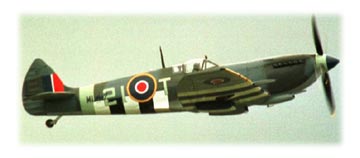
Vickers-Supermarine
Spitfire
Now 604 was equipped with Spitfire LFXV1e aircraft, in 1948
an Essex flight was established at North Weald, and soon the
whole squadron was there, as Hendon was becoming unsuitable
for fighter aircraft. John Cunningham's other job as a test
pilot for DeHavilland took much of his time and S/Leader K.T.
Lofts took over as commanding officer. 604 regained the coveted
Esher Trophy in 1949, but suffered a loss when S/L Lofts was
killed in a flying accident, S/Leader A.Deytrikh succeeded as
the C/O and now saw his squadron change over from the Spitfires
to jets with the introduction of the DeHavilland Vampire F3
these were recieved in 1951.
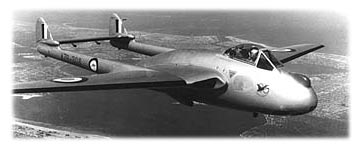
De
Havilland Vampire

Gloster
Meteor
Middlesex County council publicly honoured 604 for their achievements
on the 27th February 1952 at the Guidhall Westminster, the Gloster
Meteor F8 was issued to the squadron as its mount, with S/L
T.P Turnbull as its C/O and was flying these aircraft in the
front line of defence when in March 1957 came the decision to
disband the flying units of the Royal Auxiliary Air Force. On
the 28th of May 1960 in Whitehall Sir Frederick Handley-Page
presented the Standard awarded By the Queen to Flt Lt Buckley
a former 604 pilot, the Standard was laid up in the RAF church
of St Clement Danes, a formal parade was held, and so ended
part of Britains aviation history.
But some were not letting it end there! with a loan of £250,
a Percival Proctor 111 was aqquired G-ALOK (formerly RAF LZ589)
appeared as the mount of the County Of Middlesex squadron flying
group, the rest of the cost of £525 was subscibed by members,
known as "oscar kilo" the aircraft gave pleasure to many.
132 german aircraft were shot down by 604 squadron, a totall
of 37 DFC's or bars, 9 DFM's 4 BEM's, 3 Norwegian War medals,
and countless "mentioned in Despatches" were given to 604 squadron,
the books "Cover of Darkness" by Roderick Chisholme and "Nightfighter"
by C.F Rawnsley, John Cunninghams Radar operator are Very good
reads.
Other
Aircraft used by 604 squadron.
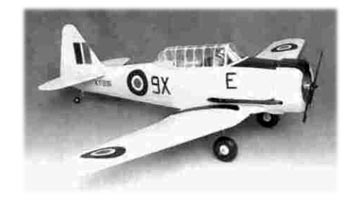
North
American Harvard
Squadron
Markings
Red and Yellow interlocking triangles carried
across the top of the wings, and along the side of the fuselage,
and the armorial bearings of the County Of Middlesex on the
tail. the Wartime Squadron code was NG, post war they were RAK,
but from 1949 they once again became NG
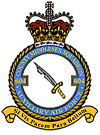
The "sword" is known as a Seax and the motto in latin translates
as "if you want peace, prepare for war" a fitting motto to a
gallant and formidable RAF squadron.
Source
of information
The excellent book now I believe out of print called " 21 Squadrons",
a history of the 21 squadrons of the Royal Auxiliary Air force.
Denis "dflite" Sharp
C.O. Warbirds 604 Squadron

|
